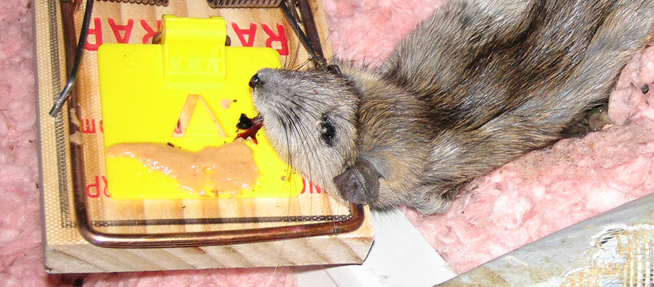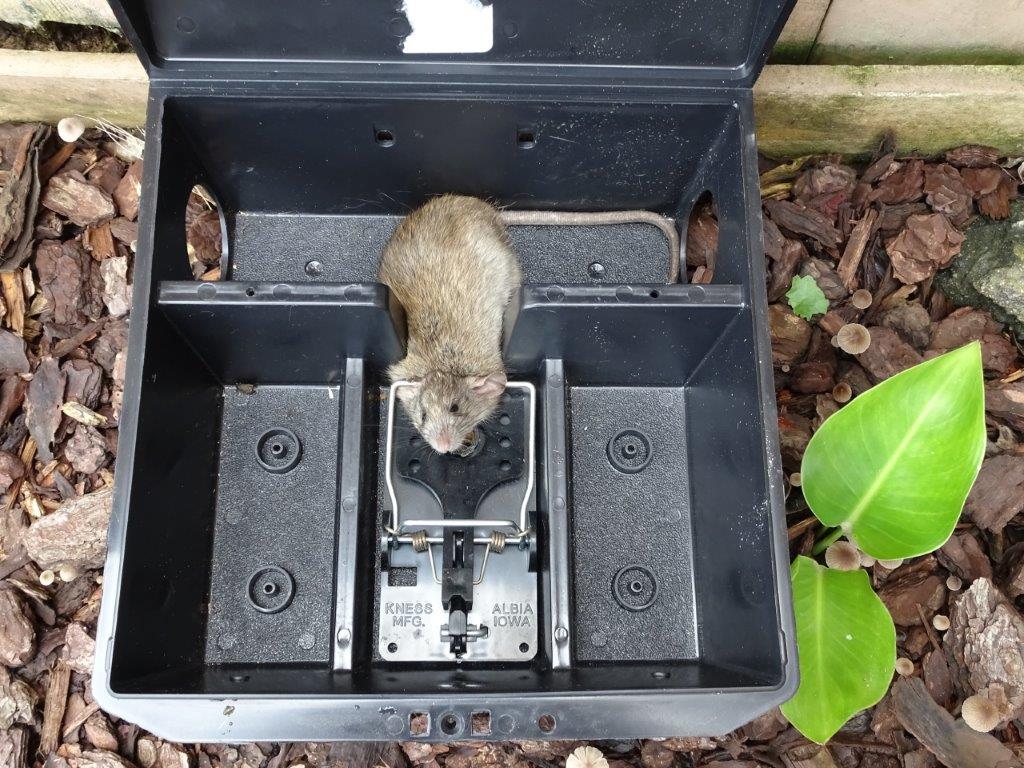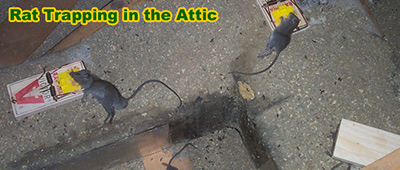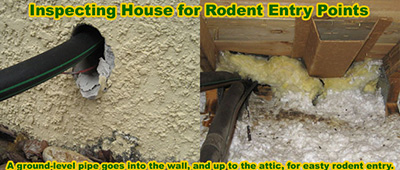Need professional rat help? What does it cost? Go to the home page
Snap traps are one of the most effective ways to deal with a rat infestation in your home or commercial property, but you might be surprised to learn that there are actually different types of traps, and even different types of snap traps. We would recommend snap traps to you because they get the job done in one. Poison is dangerous, and glue traps are entirely inhumane. Other methods, such as repellents or deterrents, just don't work and aren't worth your time. That basically just leaves snap traps, and other types of traps.
We wouldn't recommend using live cage traps to “humanely” remove these creatures from your home. The reason for this is because relocated rats very rarely make it very long in a new territory. Essentially, you're signing the rat's death warrant by releasing it back into the wild again, after you have captured it.
Glue traps are another relatively new concept, and one that many homeowners are now leaning towards. These too have their disadvantages and advantages, however, but they don't deal with the problem. The rat will now be stuck, but not dead, and you will need to resolve that particular issue. It won't be pretty.
Snap traps, on the other hand, are very effective. This is definitely the case when you have done your research, and placed those traps in exactly the right place. They need to be up against the walls, because that's where rats tend to run the most, and you will need to first figure out where the rat (or rats) are frequenting the most. You can use cornflour or flour to help you find out themes visited spots. If you sprinkle some of the white powder down and then wait a few days, you will usually find tiny little paw prints appearing in the most visited spots. That's exactly where you should be looking at placing your traps.
You will find that rat traps are slightly bigger than mouse traps, so you should make sure you're buying the right traps for the right animal. A mouse trap might not be large enough to contain a rat, and it might just maim the animal, rather than killing it like you had intended. You then have a few more options to make your choice from. There are the traditional metal pedal traps, and these days you have an “easy set" option, which is generally more plastic. These are less reliable than their metal counterparts, but are still good traps nevertheless.
There are other types of plastic snap traps now too, often called “quick set” style traps. These look a little like a hole punch, and they are reusable too. They have a quick release that enables you to release the carcass of a rat quite easily. It's like a regular snap trap, but a little more aesthetically pleasing.
Things have advanced even more than that in the world of rat traps these days too, and you can buy devices that are built to kill and hold up to three mice or rats at once. Other rodents tend to be curious about a dead friend or sibling, and if they come and investigate, there are two other traps ready to capture them too. It's taking multitasking to a brand new level. The bait is often a tad hidden with designs such as this one, and this makes it even more effective at capturing those pesky rats and mice. They need to actually go into the trap more to get to the bait, and that means they will stand no chance of avoiding the snap action. That is, of course, unless you come across a cage-shy rat who is unlikely to go further into the trap to investigate the bait. Either way, it's worth. More traps, when placed correctly and baited the right way, will mean more rat kills.
Go back to the Rats in the Attic home page.
Read more educational articles:
Should I ever poison a rat?
An analysis of inhumane glue traps for rats
Should You Use Electrocution Traps for Rats and Mice?
Which is easier to trap - mice or rats?

Humans have been dealing with rat infestation for centuries. We have invented all sorts of repellents, traps, poisons, and other methods to get rid of this problem. However, for some reason, rats always seem to find a way to survive.
The most common animal removal method used for rats is snap trapping. It is proven to be an effective and more humane alternative. If you are new to this problem, you might get overwhelmed when you find out just how many types of traps there are. It is surprising how they are different in terms of certain features. If you find yourself in this situation, don’t panic! This article will tell you all you need to know about the different types of rat snap traps and how to know which one is the best for you.
Bar Traps
You can find this type of snap trap in your local store. Most garden shops would also have it. It is one of the most common snap traps used in rats. You might have already seen one or used one before. It has a spring-loaded bar and a sensitive switch where you can place your bait. When a rat tries to move the bait, it will instantly trigger the spring bar trapping the rodent straight away.
Hidden Kill Snap Trap
This one is a little bit more complex and advanced than bar traps. It is structured with a chamber including a baited trigger at the end of it. The trap works when a rat enters the chamber and tries to move the bait just like bar traps.
Clam Snap Trap
It has the same structure and system as the bar trap, but it has a clam or jaw instead of a spring-loaded bar. It will instantly kill the rodent when the bait trigger is moved by the rodent.
Enclosed Rat Snap Trap
It has a hard plastic exterior on the outside and has a pocket where you can place a bait. After placing your bait, pull the lever and you will hear a click. When the rat enters inside, the sensor will detect its presence and instantly trigger the trap killing the rat in the process.
Catch and Release Rat Snap Trap
It has a metal cage, a small door, and a trigger. Once a rat enters the cage and tries to move the bait, it will automatically close the door trapping the rat. This is the most humane way of trapping a rodent. There is a very low chance that the rat will get hurt or injured in the process and it will be easy to release it in a suitable environment.
Now that you are familiar with the most common types of snap traps, it is time to decide which one will work best for you. The first thing to consider is to identify which type of rat you are dealing with. This will give you a better idea of the behavior of this rat. Once you get this information, you can go ahead and try to use one of the listed snap traps above.
Keep in mind that going for the most humane option is beneficial not just for the rat but also for you.








